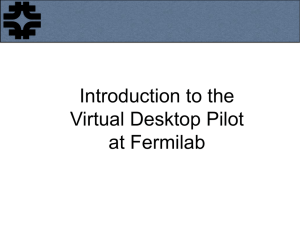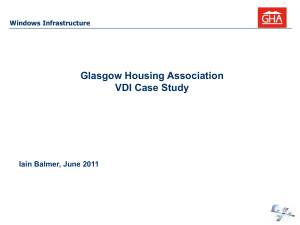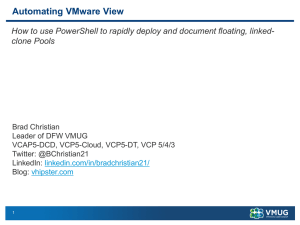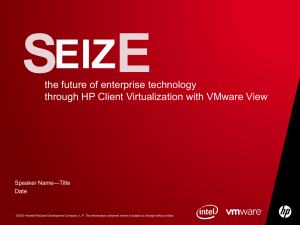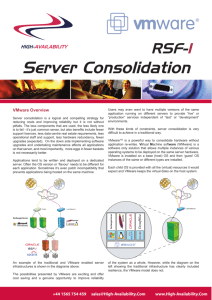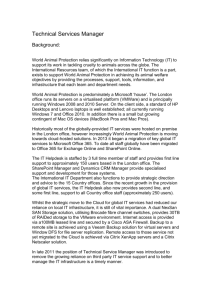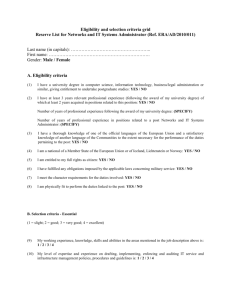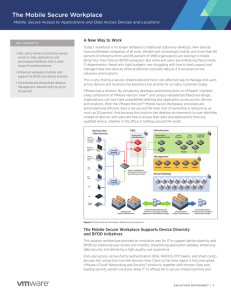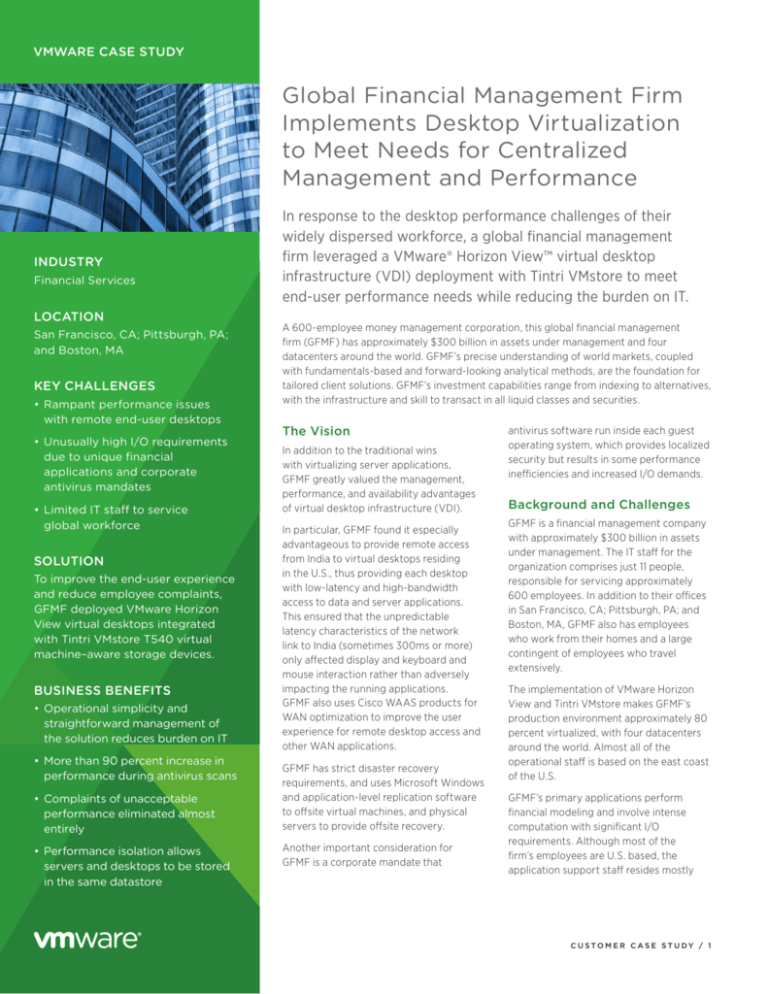
VMWARE CASE STUDY
Global Financial Management Firm
Implements Desktop Virtualization
to Meet Needs for Centralized
Management and Performance
INDUSTRY
Financial Services
LOCATION
San Francisco, CA; Pittsburgh, PA;
and Boston, MA
KEY CHALLENGES
• Rampant performance issues
with remote end-user desktops
• Unusually high I/O requirements
due to unique financial
applications and corporate
antivirus mandates
• Limited IT staff to service
global workforce
SOLUTION
To improve the end-user experience
and reduce employee complaints,
GFMF deployed VMware Horizon
View virtual desktops integrated
with Tintri VMstore T540 virtual
machine–aware storage devices.
BUSINESS BENEFITS
• Operational simplicity and
straightforward management of
the solution reduces burden on IT
• More than 90 percent increase in
performance during antivirus scans
• Complaints of unacceptable
performance eliminated almost
entirely
• Performance isolation allows
servers and desktops to be stored
in the same datastore
In response to the desktop performance challenges of their
widely dispersed workforce, a global financial management
firm leveraged a VMware® Horizon View™ virtual desktop
infrastructure (VDI) deployment with Tintri VMstore to meet
end-user performance needs while reducing the burden on IT.
A 600-employee money management corporation, this global financial management
firm (GFMF) has approximately $300 billion in assets under management and four
datacenters around the world. GFMF’s precise understanding of world markets, coupled
with fundamentals-based and forward-looking analytical methods, are the foundation for
tailored client solutions. GFMF’s investment capabilities range from indexing to alternatives,
with the infrastructure and skill to transact in all liquid classes and securities.
The Vision
In addition to the traditional wins
with virtualizing server applications,
GFMF greatly valued the management,
performance, and availability advantages
of virtual desktop infrastructure (VDI).
In particular, GFMF found it especially
advantageous to provide remote access
from India to virtual desktops residing
in the U.S., thus providing each desktop
with low-latency and high-bandwidth
access to data and server applications.
This ensured that the unpredictable
latency characteristics of the network
link to India (sometimes 300ms or more)
only affected display and keyboard and
mouse interaction rather than adversely
impacting the running applications.
GFMF also uses Cisco WAAS products for
WAN optimization to improve the user
experience for remote desktop access and
other WAN applications.
GFMF has strict disaster recovery
requirements, and uses Microsoft Windows
and application-level replication software
to offsite virtual machines, and physical
servers to provide offsite recovery.
Another important consideration for
GFMF is a corporate mandate that
antivirus software run inside each guest
operating system, which provides localized
security but results in some performance
inefficiencies and increased I/O demands.
Background and Challenges
GFMF is a financial management company
with approximately $300 billion in assets
under management. The IT staff for the
organization comprises just 11 people,
responsible for servicing approximately
600 employees. In addition to their offices
in San Francisco, CA; Pittsburgh, PA; and
Boston, MA, GFMF also has employees
who work from their homes and a large
contingent of employees who travel
extensively.
The implementation of VMware Horizon
View and Tintri VMstore makes GFMF’s
production environment approximately 80
percent virtualized, with four datacenters
around the world. Almost all of the
operational staff is based on the east coast
of the U.S.
GFMF’s primary applications perform
financial modeling and involve intense
computation with significant I/O
requirements. Although most of the
firm’s employees are U.S. based, the
application support staff resides mostly
C U S TO M E R C A S E S T U DY / 1
VMWARE CASE STUDY
VMWARE FOOTPRINT
•VMware Horizon View
•VMware vSphere ESXi 5.1
servers
•VMware vCenter™
•VMware View Composer™
APPLICATIONS VIRTUALIZED
•Financial modeling
•Accounting applications
•Trading applications
PLATFORM
•Tintri VMstore T540
storage devices
PARTNER
•Tintri
in India. GFMF’s desktop applications as
well as server applications have significant
computation and I/O needs. GFMF’s
desktops are used to run and develop
accounting applications and trading
applications as well as for traditional
office document creation, email, and Web
browsers. Microsoft Outlook, which GFMF
relies on to do financial modeling, is used in
cached exchange mode.
GFMF’s servers include many database
servers varying in size from 30GB to over
1TB. Although some of these database
servers have been virtualized, several
others still run on dedicated servers.
Individual virtual machines are configured
with from one to seven virtual disks.
GFMF currently has approximately 350
virtual machines with 700 virtual disks
running on one of their Tintri T540
VMstore arrays. Their other T540 is
dedicated primarily to virtual machines
providing disaster recovery copies of their
applications. Roughly 300 of the virtual
machines are desktops; the remainder
are servers (including a terminal services
style server providing desktops to some
users). Desktops include a mix of manually
provisioned, auto-provisioned, persistent,
and non-persistent desktops as well as
terminal service users. GFMF uses PCoIP,
RDP, and RDSH for connectivity.
VDI Storage
Implementation History
Prior to implementing Tintri storage,
GFMF’s IT administration staff would
frequently receive user complaints such
as, “I can’t work” or “My machine’s not
working.” Unfortunately, such complaints
were rarely received directly, but rather
through word of mouth up and down the
management chain. The belief was that
the complaints were due to performance
issues, but these issues were difficult to
troubleshoot due to the complexity of
the environment and the lack of direct
communication with the affected users
while the problems were occurring.
GFMF is a heavy user of hard disk storage
from a premier Fibre Channel enterprise
storage array vendor. GFMF receives a
significant discount from their vendor, and
thus their cost per GB is very attractive.
GFMF first attempted to roll out their
VDI program using Fibre Channel LUNs.
Consultants they brought in for this
effort predicted a slightly higher than
average 20 to 50 IOPS per desktop
requirement. However, measuring their
existing environment revealed that GFMF
desktops frequently consumed in excess
of 200 IOPS per desktop. GFMF attributes
their unusually high I/O requirements to
the unique financial applications they are
running as well as the in-guest antivirus
scanning applications executed by each
user.
Even during periods of moderate
workloads, their desktops in aggregate
generated approximately 5,000 or 6,000
IOPS (typically 40 MB/s to 50 MB/s).
Periods of peak I/O, however (especially
during antivirus scans), generated loads in
excess of 22,000 IOPS. Their LUN-based
Fibre Channel arrays, as configured, were
simply unable to keep up with workload
demands.
Initially GFMF decided to move to an NFS
approach from their incumbent storage
vendor, rather than use Fibre Channel
LUNs for their storage. They greatly valued
the simplicity an NFS approach would
bring, but the cost per GB figures were
alarming. GFMF thought the ideal solution
would be an NFS file-server controller
sitting in front of Fiber Channel disks
(with low per GB cost) from their existing
vendor. Unfortunately, the tremendous
number of hard-disk storage shelves
required to support their IOPS workload
made this completely impractical from a
cost perspective, and a non-starter on a
physical-space basis as well.
As a next step, GFMF evaluated products
from a number of well-established storage
vendors as well as those from several
emerging start-up vendors. Products
they looked at included hard-disk-based
storage arrays, pure NAND-flash storage
products, gateway and caching products,
and hybrid disk and flash arrays.
After narrowing the field, they brought
in products from just three vendors to
evaluate. After a fairly extensive evaluation,
Tintri was selected as the storage of choice
for all virtualized workloads, both server
and desktop.
C U S TO M E R C A S E S T U DY / 2
VMWARE CASE STUDY
“My team needed to solve
performance IOPS problems
and they needed another
project like a hole in the
head. Tintri was easy to set
up, deploy and manage. In
fact we had the system up
and running in 30 minutes
and that was before the
Tintri install rep had found
parking in our datacenter.
Our team just jumped in and
got things rolling. Tintri is a
tremendous problem solver
and easy to use.”
Chief Technology Officer,
Global Financial Management Firm
Business Results and Benefits
GFMF experienced success with their VDI
project almost immediately after bringing
in VMware Horizon View and the Tintri
VMstore. The sheer operational simplicity
of the solution was extremely welcome,
and the available performance headroom
provided with Tintri’s VMstore arrays made
managing the environment much more
straightforward.
Virus scans now take less than an hour to
complete, a tremendous improvement over
the eleven or more hours scans would take
previously. While the ESXi hosts are still
heavily exercised during the scans, this 90+
percent increase in performance makes
this corporate requirement much more
acceptable.
GFMF also greatly values Tintri’s
performance isolation when used in
conjunction with VMware Horizon View.
Tintri allows both servers and desktops
to be stored within the same datastore.
In addition to the aggregate workloads
presented by their desktops, the Tintri
T540 simultaneously supports several
server workloads, including an individual
database server regularly generating in
excess of 1,900 write IOPS and 2,400
read IOPS.
Most important, user complaints of
unacceptable storage performance
have been eliminated almost entirely.
The marked improvement in end-user
experience means users simply aren’t
complaining like they used to—a result that
is gratifying to both management and IT.
Overview of Current Horizon
View Deployment
GFMF has designed their Horizon View
deployment around the concept of a
stateless desktop block for 500 users as
shown in Figure 1.
Figure 1: 500-User Stateless Desktop Block
C U S TO M E R C A S E S T U DY / 3
VMWARE CASE STUDY
For each of the 8-node clusters, GFMF uses HP servers featuring both AMD and Intel
processors and HP FlexNet Networking. VMware vSphere® ESXi 5.1 is the hypervisor used
for all virtualization.
Figure 2: Host Server Hardware
This logical diagram of GFMF’s VDI architecture documents both the Horizon View and
Tintri VMstore portions of the architecture.
Figure 3: VDI Solution Architecture
C U S TO M E R C A S E S T U DY / 4
VMWARE CASE STUDY
The GFMF Horizon View deployment is broken down into clusters and storage pools on
the Tintri VMstore.
Figure 3: VDI Pool Storage
The Horizon View dashboard provides GFMF with actionable, real-time information on
their VDI deployment.
Figure 5: View Pool Details
C U S TO M E R C A S E S T U DY / 5
VMWARE CASE STUDY
Figure 3: View Dashboard (Datastores)
VMware, Inc. 3401 Hillview Avenue Palo Alto CA 94304 USA Tel 877-486-9273 Fax 650-427-5001 www.vmware.com
Copyright © 2013 VMware, Inc. All rights reserved. This product is protected by U.S. and international copyright and intellectual property laws.
VMware products are covered by one or more patents listed at http://www.vmware.com/go/patents. VMware is a registered trademark or
trademark of VMware, Inc. in the United States and/or other jurisdictions. All other marks and names mentioned herein may be trademarks
of their respective companies. Item No: 4035-VMW-CS-TINTRI-UNLET-20130503-WEB

